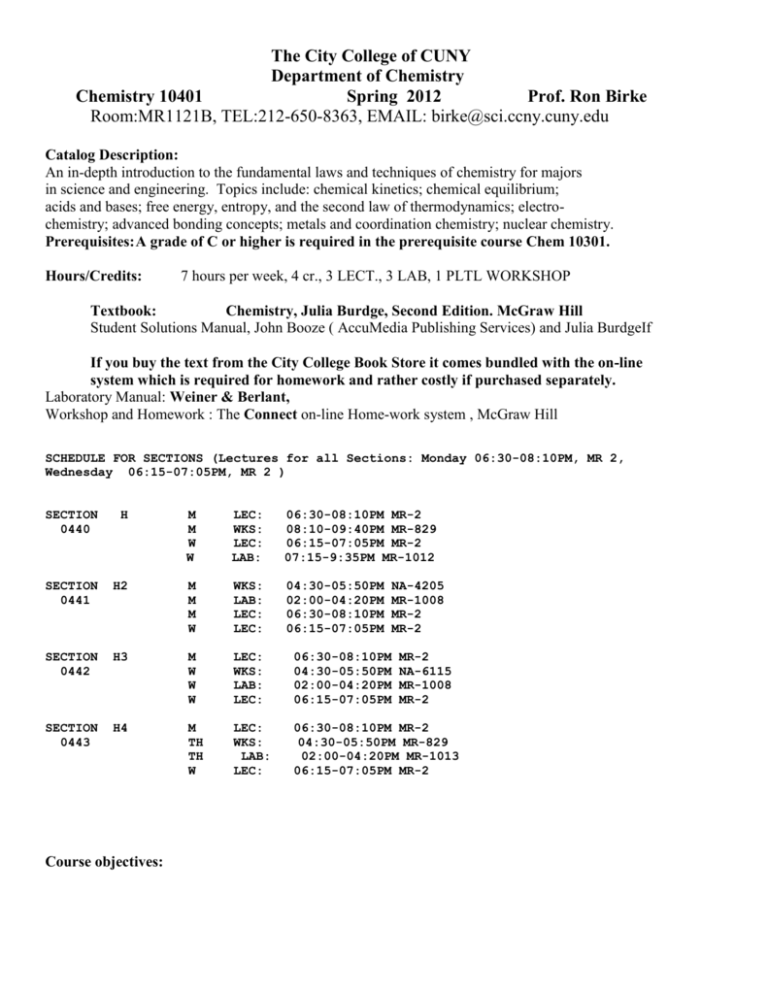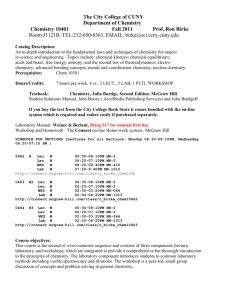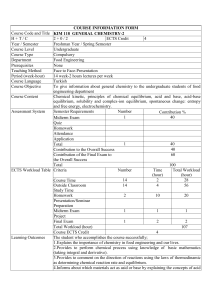Chemistry 104
advertisement

The City College of CUNY Department of Chemistry Chemistry 10401 Spring 2012 Prof. Ron Birke Room:MR1121B, TEL:212-650-8363, EMAIL: birke@sci.ccny.cuny.edu Catalog Description: An in-depth introduction to the fundamental laws and techniques of chemistry for majors in science and engineering. Topics include: chemical kinetics; chemical equilibrium; acids and bases; free energy, entropy, and the second law of thermodynamics; electrochemistry; advanced bonding concepts; metals and coordination chemistry; nuclear chemistry. Prerequisites: A grade of C or higher is required in the prerequisite course Chem 10301. Hours/Credits: 7 hours per week, 4 cr., 3 LECT., 3 LAB, 1 PLTL WORKSHOP Textbook: Chemistry, Julia Burdge, Second Edition. McGraw Hill Student Solutions Manual, John Booze ( AccuMedia Publishing Services) and Julia BurdgeIf If you buy the text from the City College Book Store it comes bundled with the on-line system which is required for homework and rather costly if purchased separately. Laboratory Manual: Weiner & Berlant, Workshop and Homework : The Connect on-line Home-work system , McGraw Hill SCHEDULE FOR SECTIONS (Lectures for all Sections: Monday 06:30-08:10PM, MR 2, Wednesday 06:15-07:05PM, MR 2 ) SECTION 0440 H M M W W LEC: WKS: LEC: LAB: 06:30-08:10PM MR-2 08:10-09:40PM MR-829 06:15-07:05PM MR-2 07:15-9:35PM MR-1012 SECTION 0441 H2 M M M W WKS: LAB: LEC: LEC: 04:30-05:50PM 02:00-04:20PM 06:30-08:10PM 06:15-07:05PM SECTION 0442 H3 M W W W LEC: WKS: LAB: LEC: 06:30-08:10PM 04:30-05:50PM 02:00-04:20PM 06:15-07:05PM SECTION 0443 H4 M TH TH W LEC: WKS: LAB: LEC: 06:30-08:10PM MR-2 04:30-05:50PM MR-829 02:00-04:20PM MR-1013 06:15-07:05PM MR-2 Course objectives: NA-4205 MR-1008 MR-2 MR-2 MR-2 NA-6115 MR-1008 MR-2 This course is the second of a two semester sequence and consists of three components (lecture, laboratory, and workshop), which are integrated to provide a comprehensive but thorough introduction to the principles of chemistry. The laboratory component introduces students to common laboratory methods including visible spectroscopy and titrations. The workshop is a peer-led, small group discussion of concepts and problem solving in general chemistry. After completing this course students should be able to: 1. Discuss properties of states of matter and solutions and the factors that affect solubility, and understand and interpret colligative properties, molality, and colloids and their applications to solutions. 2. Understand chemical kinetics, reaction rates, factors that influence the reaction rates, reaction mechanisms, and catalysis. 3. Develop conceptual knowledge of equilibrium, equilibrium constant, and their applications to systems at equilibrium, and apply Le Chatelier’s principles and its applications to systems at equilibrium. 4. Develop knowledge about acid-base equilibria, the pH scale, perform calculations into the pH of solutions of acids and bases of varying strengths, predict the strength of an acid or base by examining its structural properties, and apply principles of buffered solutions and the role they play in the environment and biological system. 5. Explore solubility, factors the affect solubility, and the separation of ions by precipitation. 6. Define entropy and the Second Law of Thermodynamics and how to relate it to everyday life, define Gibbs free energy and its relation to the enthalpy and entropy, and manipulate equations and make sense out of relating the free energy, enthalpy, entropy, and the equilibrium constants. 7. Develop the skills for balancing oxidation-reduction reactions, explore electrochemical cells and the effect of concentration on the cell potential, and Be aware of how batteries operate and building different types of batteries. 8. Explore nuclear chemistry by exploring radioactivity, patterns of nuclear stability , and rates of decay. 9. . Discuss properties of complex ions and the nature of metals and semiconductors. 10. Develop the capabilities to solve problems by combining several concepts in chemistry. 11. Write a laboratory report including data and analysis. 12. Be able to conduct a variety of experiments (titrations, spectroscopic) including accurate recording of results and preparation of calibration curves. 13. Work as part of a problem solving team to solve chemistry problems. Topics covered: Department outcomes a, d a a, d a, b, e a, e a, b, e a, e a d, e g c, d, e f, h 1. States of Mater and Intermolecular Forces 2. Physical Properties of Solutions 3. Chemical Kinetics: Rates and Mechanisms of Chemical Reactions 4. Chemical Equilibrium 5. Acids, Bases, and Acid–Base Equilibria 6. More Equilibria in Aqueous Solutions: Slightly Soluble Salts and Complex Ions 7. Thermodynamics: Spontaneity, Entropy, and Free Energy 8. Electrochemistry 9. Nuclear Chemistry Relationship of course to program outcomes: The outcome of this course contribute to the following departmental Course educational outcomes: Objective Numbers a. demonstrate an understanding of the fundamental principles 1-8 of chemistry, including atomic and molecular structure, quantum chemistry, chemical bonding, stoichiometry, kinetics and mechanism, equilibrium, thermochemistry and thermodynamics, molecular structure and function, electrochemistry, and the periodic chemical properties of the elements. b. apply the fundamental principles of chemistry to life sciences, 4, 6 the environment, materials, engineering, and emerging technological fields of chemistry, as well as to everyday situations. c. conduct experiments and learn fundamental laboratory skills 11 d. analyze and interpret data 1, 3, 9, 11 e. apply mathematical concepts to chemical problems 4-7, 9, 11 f. g. h. i. j. k. work as part of a problem-solving team convey facts, theories and results about chemistry in written form use oral presentation to convey facts, theories and results about chemistry access and utilize chemical information technology design and execute scientific research apply ethical responsibilities and professional conduct 12 10 12 Assessment tools: The final grade is calculated as follows: Best two scores of the three in-class examinations * (40%) Final Exam (30%) Laboratory (15 %) Workshop (5%) Online Homework (MasteringChemistry) (10%) * The lowest grade exam will be dropped. Missing an exam will result in receiving a zero grade for that particular exam and thus dropping that grade. There will not be any Make-up Exams. Office Hours: Tues: 3:00 am – 5:00 pm Or by appointment Office is located in the science ( MR) building in room 1121B Absence Policy Any student who misses more than four classes will be dropped from the course. Workshop and lab have the same absence policy, which is that any student who misses more than two session without a doctors excuse will be dropped from the course. If you are more than 10 minutes late it will be counted as an absence. Statement on Academic Integrity The CCNY policy on academic integrity will be followed in this course. The document can be found through the CCNY website by clicking on Current Students Academic Services Policy on Academic Integrity. All students must read the details regarding plagiarism and cheating in order to be familiar with the rules of the college. Cases where academic integrity is compromised will be prosecuted according to these rules. In addition, the Policy of Academic Integrity can be found in the Undergraduate Bulletin 2007-2009 in Appendix B.3 on page 312. Class Schedule Lectures Topics of Lectures M 1/30 Chapter 12: INTERMOLECULAR FORCES and AND PHYSICAL PROPERTIES OF LIQUIDS Chapter 12 ( 12.1 – 12.2 and 12.6) W 2/1 Chapter 12 Contiued (12.7)) , Chapter 13 (13.1 -13.4) Optional Problems Ch. 12 :19, 85, 97, 99, 141. M 2/ Chapter 13: PHYSICAL PROPERTIES OF SOLUTIONS Chapter 13 continued ( 13.5- 13..7)) Optional Problems Ch. 13 : 15,17,19,21,23, 33, 37, 57,59, 61, 65, 75, 83, 87. W 2/8 Chapter 14: CHEMICAL KINETICS Chapter 14 ( 14.1- 14.2) M 2/13 College Closed Lincoln’s Birthday W 2/15 M. 2/20 Chapter 14 continued ( 14.3) College Closed Presidents Day Th 2/21 Tuesday Monday Schedule Chapter 14 continued ( 14.4 – 14.6) Optional Problems Ch14 : 15, 17, 19, 21, 27, 31, 45, 59, 85, 101. W 2/22 Chapter 15: CHEMICAL EQUILIBRIUM Chapter 15 ( 15.1 – 15.2) Optional Problems Ch. 15: 23, 27, 31, 33, 35, 41,45, 47, 57, 63, 67, 87, 121, 125. M 2/27 Chapter 15 continued ( 15.3-15.4 ) W 2/29 Chapter 15 continued ( 15.5-15.46 ) M 3/5 First Lecture Exam: Chapters 12, 13, 14 W 3 /7 Chapter 16: ACIDS and BASES Chapter 16 ( 16.1-16.2) M 3/12 Chapter 16 continued (16.10- 16.11) Optional Problems Ch. 16 : 5, 7, 15, 21, 25, 29, 31, 41,53, 57, 59, 69, 71, 85, 103, 105, 119, 147. W 3/14 Chapter 16 continued Chapter 16 continued ( 16.3-16.6) M 3/19 Chapter 16 continued (16.10- 16.11) W 3/21 Chapter 17: ACID_BASE EQUILIBRIUM and SOLUBLE EQUILIBRIUM AND COMPLEX IONS Chapter 17 (17.1- 17.2) Optional Problems Ch. 17 : 5,11, 19, 27, 29, 33, 35, 49, 53, 57, 65, 69, 91, 97, 99, 105, 115,121, 131. M 3/26 Chapter 17 continued ( 17.3-17.5) W 3/28 Chapter 17 continued (17.6) M 4/2 SECOND EXAMINATION: Chapters 16, 17 Chapter 19 continued (19.1- 19.2) W 4/4 Chapter 18: ENTROPY , FREE ENERGY and EQUILIBRIUM Chapter 18 continued (18.1- 18.2) Optional Problems: Ch. 18: 13, 17, 21, 29. 33, 41, 45, 47, 75, 85, 95, 113. Spring Recess 4/6-4/19 M 4/16 Chapter 18 continued ( 18.3-18.5) W 4/18 Chapter 18 continued (18.6- 18.7) Th 4/19 Last Day for “W’ grades M 4/23 Chapter 19 : ELECTROCHEMISTRY Chapter 19 (19.1- 19.2) W 4/25 Chapter 19 continued (19.3- 19.4) Optional Problems Ch. 19: 11, 21, 23, 29, 33, 39, 43, 47, 67, 71, 73, 123, 125. M 4/30 Chapter 19 continued ( 19.5-19.6) W 5/2 M 5/7 Chapter 19 continued (19.7- 19.8) Chapter 19 continued (19.9- 19.11) Chapter 20 : NUCLEAR CHEMISTRY Chapter (20.1-20.2) Optional Problems Ch 20 : 5, 19, 21, 27, 79, 81, 83, 87, 97. W 5/9 Chapter 20 continued ( 20.3-20.4) M 5/14 THIRD EXAMINATION: Chapters 17, 18 Tu 5/15 Last day of SRING SESSION FINAL EXAMS, May 17-24: comprehensive. Chapters 11( parts) ,12, 13, 14, 15, 16, 17, 18, 19, 20 (parts) Tentative Grade Assignment A+ A AB+ B BC+ C CD F 96-100 90-95 88-89 86-87 82-85 80-81 77-79 72-76 70-71 60-69 0-59 Study Guides: 1. Plan at least three hours of study (reading the chapter and completing the problem sets “homework”) time for every hour you spend in class. 2. Do the problem sets individually (without help from friends or classmates) initially. Please look at a related problem in the solution manual to help you solve the assigned problem. If you are still unable to solve the problem, then ask a friend, classmate, workshop leader, TA, or Professor for help. 3. Read the book and take notes as you read. 4. Attend workshop: finish the Self-Test, finish the workshop problems, and ask questions. 5. Seek help when you have difficulty (office hours, tutoring, study groups with workshop).







